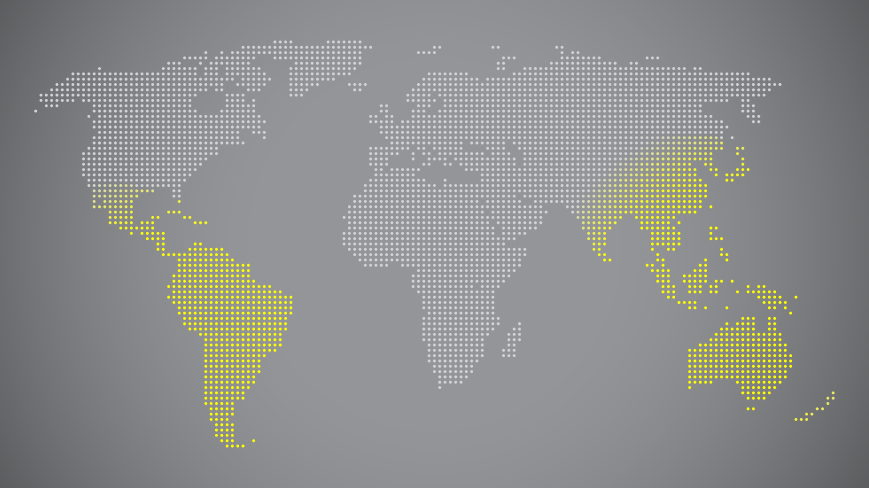Refresh your global marketing strategy with these key trends and opportunities happening in the APAC and LATAM regions.
With 50% of the total population actively accessing the internet, digital is more present than ever in our lives. The ever-changing evolutions and trends here in North America can make it difficult to stay abreast of what else is going on in our industry. But as multinational marketers know, we must stay informed on what is happening across the globe as to see beyond the “one size fits all” mindset. From connectivity to infrastructure, mobile to social, different regions of the world are experiencing varying levels of advancements or drawbacks that need to be taken into consideration when it comes to digital marketing.
To help marketers get up to speed on international knowledge, we put together a two-part series rounding up some of the top marketing trends by region. For the first, we cover APAC and LATAM; stay tuned for part two covering the Middle East, Africa, and Europe.
APAC (Asia and Pacific): E-Commerce, Social Media, and Video
While China dominates e-commerce, creating a big opportunity for marketers in APAC, efforts across the region can focus on social media and video, as engagement in these areas is growing.
E-commerce soars, moves mobile:
China dominates the APAC region as the biggest e-commerce market in the world, which can be largely attributed to marketplace giants Alibaba and JD. At $1.13 trillion total, the e-commerce segment represents a hefty 23% slice of China’s overall retail market. Mobile is a huge driver of this climb, as experts predict that over 75% of e-commerce purchases will be made via mobile by 2018.
Brands will need to consider a mobile-first strategy, redesigning e-commerce sites to have sophisticated mobile capabilities. Additionally, marketers should be employing advanced data collecting techniques, making smart use of the purchase behavior data now available, and measuring the impact of their marketing efforts to the final online conversion.
Social media usage:
Targeting individual users via paid social media advertising has proven difficult because of a proliferation of fake social media accounts. The issue of fraudulent traffic spans as far as “click farms” being used, where workers are paid to generate fake reviews and engagements on social sites. Instead of wasting spend on exposure to fake accounts, many brands resort to an inbound strategy to bring real users to them, such as offering branded chatbots.
Across the East China Sea, the island nation of Japan fares far better when it comes to social media growth. While consumers engage readily with the popular messaging app Line, attracting over 77% of smartphone users, Instagram has seen the largest growth year-over-year, providing greater opportunities for brand awareness campaigns.
Branded video consumption:
In India, a country predicted to have 700 million mobile phone users by 2020, people readily share and enjoy branded video content, to the point where video represents over half of all mobile data use. However, flooded email inboxes and social media profiles have caused unsubscribes to go up, increasing the need for a segmented strategy that sends only the most relevant content.
LATAM (Latin America): Mobile Growth
With the rise of mobile, markers reaching audiences in LATAM should focus efforts on communities of users who spend time on connected activities such as social media and games.
Mobile connectivity on the rise:
Mobile device growth has taken off in South and Central America, bringing internet access to millions and creating new communities centered on connected activities. Mobile subscribers grew by more than eightfold between 2010 and 2015, reaching 58% of the region. Among these mobile users, social media and mobile games are especially popular, with the latter achieving 56% growth last year. Latin Americans were also described as the most avid social media users worldwide in 2016, spending a majority of time on platforms such as WhatsApp, Facebook, Facebook Messenger, Instagram, and YouTube.
This growth presents opportunities for LATAM-based brands to create social campaigns that find innovative ways to inspire organic conversations. As social networks continue to become “walled gardens,” encouraging users to stay in-app for communication and purchases, brands will be faced with creating new avenues for engagement.
Mobile infrastructure still in progress:
At the same time, mobile infrastructure needs to catch up in order to reverse the current trend of low online sales conversions. A majority of people in areas of this region do not have bank accounts due to inflation, distrust in banks, and stiff financial regulations. As such, growth in convenient mobile-based payment systems (allowing users without a bank account to make purchases online) will spur growth in e-commerce and likely m-commerce. Moving forward the market shows great promise, with over 10 million “mobile money” accounts in service – surpassing bank account ownership in some countries – delivering more opportunity, choices, and better convenience to online shoppers.
These trends capture both emerging and well-developed markets in some of the world’s most culturally rich areas. The speed of globalization has brought internet access to millions of additional users while opening up marketing inroads to massive scalability. At the same time, markets like Japan reflect how unique tastes influence culture and marketing in highly mature and developed economies.
Stay posted for the second part of this series covering Europe, the Middle East, and Africa – to be published next week.

